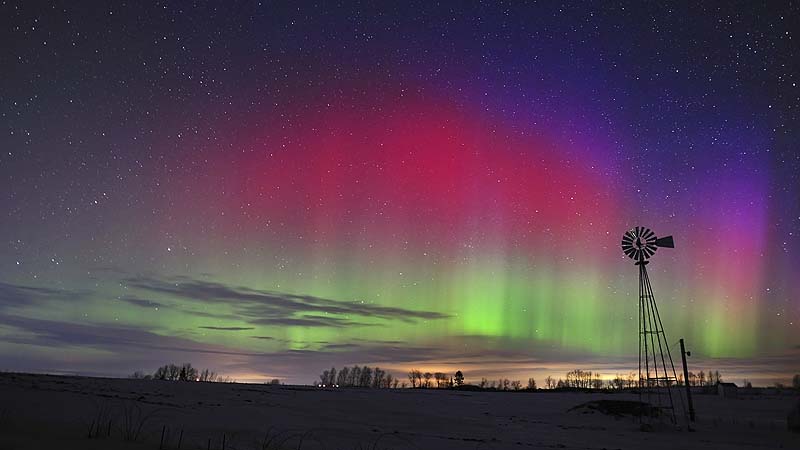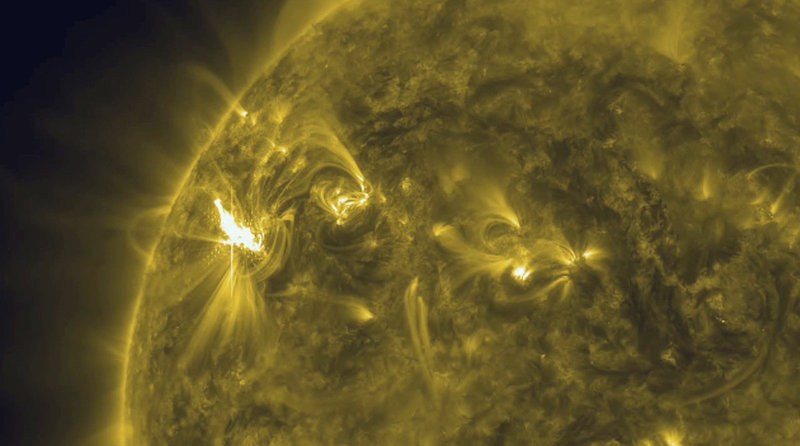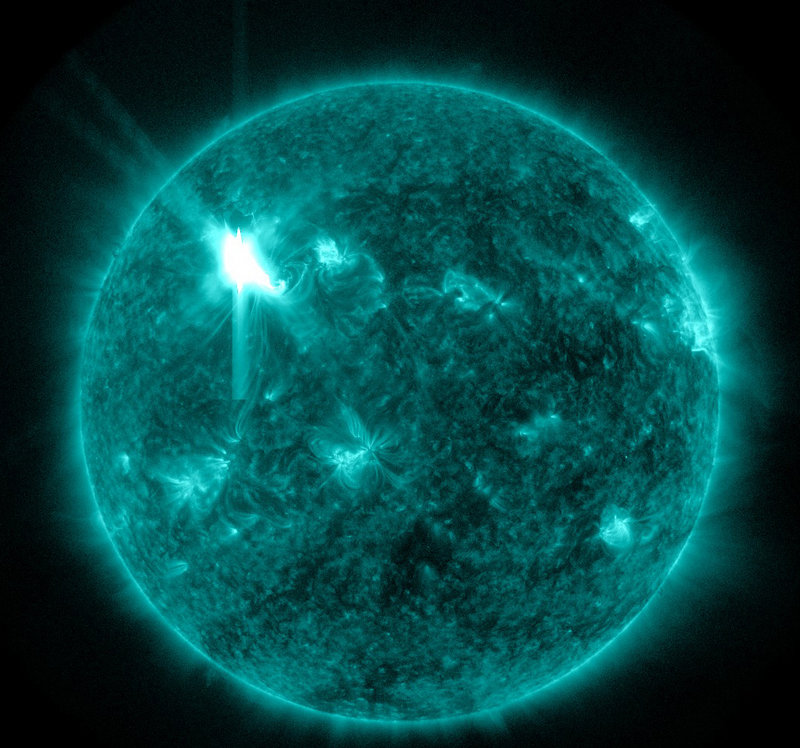WASHINGTON — One of the strongest solar storms in years engulfed Earth early Thursday, but scientists say the planet may have lucked out.
Hours after the storm arrived, officials said there were no reports of problems with power grids, GPS, satellites or other technologies that are often disrupted by solar storms.
But that still can change as the storm shakes the planet’s magnetic field in ways that could disrupt technology but also spread colorful Northern Lights. Early indications show that it is about 10 times stronger than the normal solar wind that hits Earth.
The storm started with a massive solar flare Tuesday evening and grew as it raced outward from the sun, expanding like a giant soap bubble, scientists said.
The storm struck about 6 a.m. EST in a direction that causes the least amount of problems, said Joe Kunches, a scientist at the National Oceanic and Atmospheric Administration’s Space Weather Prediction Center.
“It’s not a terribly strong event. It’s a very interesting event,” he said.
Initially, scientists figured the storm would be the worst since 2006, but now it seems only as bad as ones a few months ago, he said.
Forecasters can predict the speed a solar storm travels and its strength, but the north-south orientation is the wild card. And this time, Earth got dealt a good card with a northern orientation, which is “pretty benign,” Kunches said. If it had been southern, that would have caused the most damaging technological disruption and biggest auroras.
“We’re not out of the woods,” Kunches said Thursday morning. “It was a good start. If I’m a power grid, I’m really happy so far.”
But that storm orientation can and is changing, he said.
“It could flip-flop and we could end up with the strength of the storm still to come,” Kunches said from the NOAA forecast center in Boulder, Colo.
Those in Maine who rely on satellite, radio and electronic equipment say they are watching the storm closely.
Stargazers say the storm could create a spectacular displays of northern lights, or aurora borealis, if the weather cooperates.
“If we get a clear night we are going to get a nice display,” said Paul Burke, an amateur astronomer who also works as an air traffic controller at the Portland International Jetport.
Burke, who lives in Pittsfield, operates an observatory in his backyard. Burke won’t be using his observatory tonight.
“The best way to see the northern lights is with the naked eye,” Burke said.
Ron Burk is president of the Astronomical Society of Northern New England. The group operates the Starfield Observatory in Kennebunk.
Burk said he was struck by how fast the solar storm would reach Earth, which is about 93 million miles away from the sun. The observatory won’t be open tonight but Burk said the public is invited to the group’s stargazing parties, set for March 16 and March 23.
Those in Maine hoping to see the northern lights could end up being disappointed, even though the peak time for watching them in North America will be tonight.
The forecast for later this afternoon and evening is for cloudy skies across most of the state, said Margaret Curtis, a meteorologist with the National Weather Service in Gray.
“It’s looking very rainy but there is a chance it could clear out during the wee morning hours on Friday,” Curtis said.
Central Maine Power Co. and ISO New England, which manages the power grid for 6.2 million customers in Maine and the five other New England states, along with other power companies, is monitoring the storm closely.
Ellen Foley, a spokeswoman for ISO New England, said everyone at CMP, from the dispatchers to line workers, has been put on notice that the storm could cause power outages or equipment failures.
In 1989, a strong solar storm knocked out the electricity grid in Quebec, causing 6 million people to lose power.
North American utilities so far have not reported any problems, said Kimberly Mielcarek, spokeswoman for the North American Electric Reliability Corporation, a consortium of electricity grid operators.
A massive cloud of charged particles can disrupt utility grids, airline flights, satellite networks and GPS services, especially in northern areas. But the same blast can also paint colorful auroras farther from the poles than normal.
Astronomers say the sun has been relatively quiet for some time. And this storm, while strong, may seem fiercer because Earth has been lulled by several years of weak solar activity.
The storm is part of the sun’s normal 11-year cycle, which is supposed to reach a peak next year. Solar storms don’t harm people, but they do disrupt technology. And during the last peak around 2002, experts learned that GPS was vulnerable to solar outbursts.
Because new technology has flourished since then, scientists could discover that some new systems are also at risk, said Jeffrey Hughes, director of the Center for Integrated Space Weather Modeling at Boston University.
The region of the sun that erupted can still send more blasts our way, Kunches said. Another set of active sunspots is ready to aim at Earth.
“This is a big sun spot group, particularly nasty,” NASA solar physicist David Hathaway said. “Things are really twisted up and mixed up. It keeps flaring.”
Storms like this start with sun spots, Hathaway said.
Then comes an initial solar flare of subatomic particles that resemble a filament coming out of the sun. That part from this storm hit Earth only minutes after the initial burst, bringing radio and radiation disturbances.
After that comes the coronal mass ejection, which looks like a growing bubble and takes a couple days to reach Earth.
For North America, the good part of a solar storm — the one that creates more noticeable auroras or Northern Lights — peaks Thursday evening. Auroras could dip as far south as the Great Lakes states or lower, Kunches said, but a full moon will make them harder to see.
Still, the potential for problems is widespread. Solar storms have three ways they can disrupt technology on Earth: with magnetic, radio and radiation emissions. This is an unusual situation, when all three types of solar storm disruptions are likely to be strong, Kunches said.
Solar storms can bring additional radiation around the north and south poles — a risk that sometimes forces airlines to reroute flights.
Satellites can be affected, too. NASA spokesman Rob Navias said the space agency wasn’t taking any extra precautions to protect astronauts on the International Space Station from added radiation.
“As unusual as it sounds, solar storms are a standard aspect of operating the grid,” said CMP spokesman John Carroll. “It’s one of those little understood phenomena that we have to cope with on a fairly regular basis.”
The United States Coast Guard said fishing, recreation and cargo vessels that rely on GPS for navigation could be affected.
Solar storms have been known to make GPS less accurate, and there can even be outages.
The strongest solar storm in recorded history was probably in 1859, Kunches said.
Staff Writer Dennis Hoey can be contacted at 791-6365 or at:
dhoey@pressherald.com
Send questions/comments to the editors.





Success. Please wait for the page to reload. If the page does not reload within 5 seconds, please refresh the page.
Enter your email and password to access comments.
Hi, to comment on stories you must . This profile is in addition to your subscription and website login.
Already have a commenting profile? .
Invalid username/password.
Please check your email to confirm and complete your registration.
Only subscribers are eligible to post comments. Please subscribe or login first for digital access. Here’s why.
Use the form below to reset your password. When you've submitted your account email, we will send an email with a reset code.